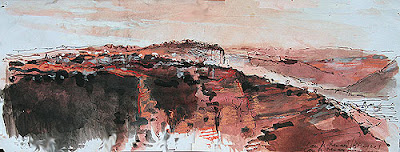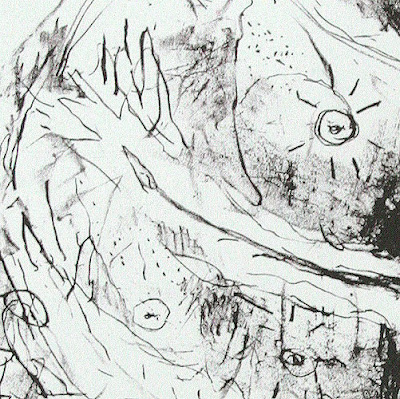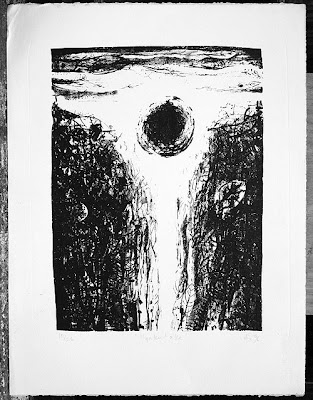Second Posting of Two : Marcilhac sur Célé – Pen & Ink – How to Draw Rocks, Cliffs … & Comets??? – Leonardo da Vinci – Stone Lithography – Mythological Images
PART ONE OF THIS TWO-PART POSTING – How to draw rock & cliffs
1996
Ink & Pastel
© The Artist.
1997
Stone Lithography
Full sheet BFK Rives 180 gms, 65 x 50 cm
Copyright – the artist
Edition sold out
1996
Ink & Pastel
© The Artist.
>>>>>>>>>>>>>>>>>>>>>>>>>>>>>>>>>>>>>>>
Pen & Ink Drawing for Printmaking
Printmaking is wonderful for an artist’s drawing.
And because stone lithography is fundamentally ‘non correctable’, this medium demands a lot of ‘commitment’ in one’s drawing skills (helped my watercolour as well). Pen & ink is another fundamentally non-correctable medium. It is not by any accident that the one of Master artists of lithography , Toulouse Lautrec (another artist from South West of France), was also a master of pen & ink.

I however wasn’t a master of the Pen’n’Stink. Smudge’n’ Rub… My painterly (in the sense that the art historian Woëfflin intended, blurred ‘lost’ edges, sensual ‘sfumato’) urges at the time was to rub & to scratch & ‘rough it up’. Make a ‘bed’ from which the image, the passion could rise. Not quiet the same as correcting. A certain element of massage involved. I learnt life drawing using charcoal this way. Smudge’n’Rub.
But actually, to be honest & unrhetorical, a good part of this was pure panic. Panic in front of these cliffs & rocks. Panic akin to that which beginners often feel. That feeling of how do I do this??? It’s so difficult!!!
Ink & watercolour
25 x 32 cm – Papier fait à la main par Monsieur Duchêne
© Tous Droits Reservées
Only when he no longer knows what he is doing, does the painter make good paintings. – Degas
2. Don’t spill the ink (dedicate a small ‘ink well’ pot, rather than a large,aawkard ink bottle). Or if you do spill, try & make use of the ‘happy accident’. Or if you must, then it is even better to spill the ink deliberately. But are you sure to achieve a good result? Risk is risk.

‘Chateau des Anglais, Vallée du Célé’
1996
Ink & Gouache
28 x 38 Vellum fait à la main par Monsieur Duchêne
Tous droits resvervées.
‘Two Trees (Quercus Quercus)’ 1997
30 x 30 cm
Pen & ink
Copyright – the artist
email me to buy a limited edition giclee print of this artwork.
>>>>>>>>>>>>>>>>>>>>>>>>>>>>>>>>>>>>>>>>>>>>>>>>>>
How to draw rocks & cliffs? How to paint them? How to artists prints of them?
1996
Ink
© Tous Droits Reservées
‘Study of a Tuscan Landscape – Val d’Arno’
1473
Pen & Ink, nib on vellum
Approx 15 x 22 cm
Uffizi Museum
In the Célé, in 1996, I had Leonardo da Vinci’s pen & ink nib drawings in mind. You know the ones in the Windsor Leoni Volume? The pen & inks of geological stratus. As if the earth is moving. Only it’s embrassing to mention a genius in context of my feeble efforts.
‘Study of a Ravine in a Rocky Landscape’
C.1473
Pen & Ink, nib on vellum
Approx 22 x 15 cm
Windsor Leoni Volume
Stone Lithography
Full Sheet BFK RIVES 180 gms, 65 x 50 cm
Edition 0f 14
© Tous Droits Reservées
But I confess however, it was precisely the wild untamed nature of the rocks & cliffs that attracted me. Do we always have to do a ‘clean-up’ job on ‘untidy’ nature?
The limestone cliffs & rocks themselves, I felt, are the wierdest, wildest, craziest landscape. I can see in retrospect that it was ME projecting my fantasies into THEM. Or was it? Maybe, maybe. And in this, I am in keeping with the great master painters of Prehistoric Cave Paintings. Even Leonardo stared into mold on the walls & saw wild battles & who knows what else ! 🙂
But when other people stare into them, all they see is chaos that needs to be straightened out.
The Technique of Stone Lithography
In the technique of stone lithography, that the artist draws on the actual stone.. The stone itself is a very faultless, very compact form of limestone. To my knowledge, there’s only two really good quarries , one comes from under the Alps & the other from under the Himalayas. The weight of the mountains presses the stone to a seemless, faultless purity. The feel of the stone is so …. beautiful. The fine grain holds the grease in a way that makes even the smoothest, finest hot pressed paper course in comparison. If you look closely at the detail below, you can see something of the grain of the stone
stone Lithography
© Tous Droits Reservées
So without going into ardious details, the stone ‘plate’ must be developed to hold the image. When the drawing (grease based)/developing (gum arabic)/etching (weak nitric acid) stages are complete, the stone must then washed out with water, it’s humidity maintained & then be inked up…….. The image appears out of the stone! I’d say akin to developing a photo but it’s much quicker than that. It’s with the ‘snap-stick-stick’ of the inked up leather rollers – whhah! behold, the image appears!
>>>>>>>>>>>>>>>>>>>>>>>>>>>
Back to the Valley…
Stone Lithograph
Artists-proof, image non-editioned.
© Tous Droits Reservées
Things started taking on a mythical bent in my mind’s eye. It was the Vernal Equinox. Fossils & faces appearing out of the stone. It wasn’t scary. It wasn’t drug induced. It felt good. Inspiration. The cliffs themselves are reminders that there are other time-scales other than the tic-toc time of ‘seven score years & ten’. By the 22 of march,1996, Hyakutake attained mag 2 when it entered SE Bootes.
Stone Lithography
Full Sheet BFK RIVES 180 gms, 65 x 50 cm
Edition 0f 50
© Tous Droits Reservées
150 euros or equivalent in US dollars or GBP sterling
email me to buy a print via Paypal
L’ancien se meurt, le nouveau ne parvient pas à voir le jour, dans ce clair-obscur surgissent les monstres – Gramsci ( ‘ The old is dying & the new has not yet seen the light of day. in the twilight monsters are rearing’ Gramsci)
‘6 Germinal’
Stone Lithography
Full Sheet BFK RIVES 180 gms, 65 x 50 cm
Edition 0f 50
© Tous Droits Reservées
150 euros or equivalent in US dollars or GBP sterling
email me to buy a print via Paypal
Some thoughts about ‘Mythological Images’ & Prehistory ….
The meaning of things aren’t stable. Anything can mean almost anything – Jasper Johns
Images such as advertising campaigns (yes we live in beautiful times of great luxury), swastiskas (cruel times too) or atomic mushroom clouds are strong enough images to move many. They can motivate & they do motivate. (though I was surprised to see years later that the seed- in-a-fountain motif that I used ‘HYAKUTAKE’ re-emerged in the logo for ‘Sport for All’ UK & the single leaf motif that I used in ‘6 GERMINAL’ again as logo for the Front Nationale, France albeit it’s an oak leaf).
For me, the hand print on the wall of Painted Prehistoric Cave at Pech-Merle in the Valley of the Célé, is a great image of our past. Both as humans & as artists. There is hope in these images. Whatever they meant to the artists &/or shamans (?) of Prehistory that made this image ….
(we don’t even know if these particular underground images were meant for ‘mass’ consumption by all the tribe. Personally I doubt it, or else more traces, foot prints, prehistoric litter and the such, would have been left on the cave floors etc. Maybe we will never know the answer to this. Much of the evidence has disappeared. Lascaux, for example, was trampled underfoot & opened to the public, before a ‘complete closure’ type of conservation & archeological expertise was the norm, as is now the case)
……they now mean something else to us in the twenty-first century. They are iconic of our beginnings.
Gravettian Period
hand size is that of an adult
Red iron oxide on cave wall, situated about 500 metres from orginal entrance to cave (if I remember rightly). Blown technique.
Grotte de Peche-Merle, Vallée du Célé, Lot, France
Read more of my musings about Prehistoric Cave Art in the prehistory category of this blog
Prehistoric Art: The Symbolic Journey of Humankind – Randall White, ISBN-10: 0810942623
The Mind in the Cave: Consciousness and the Origins of Art – David Lewis-Williams, ISBN-10: 0500284652
Cave Art – Jean Clottes, ISBN-10: 0714857238
[button color=”green” size=”medium” align=”center” link=”https://www.artists-atelier.com//category/blog/prehistoric-art/”]More Musing About Prehistoric Art[/button]


















